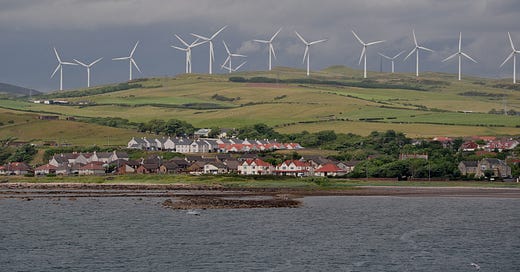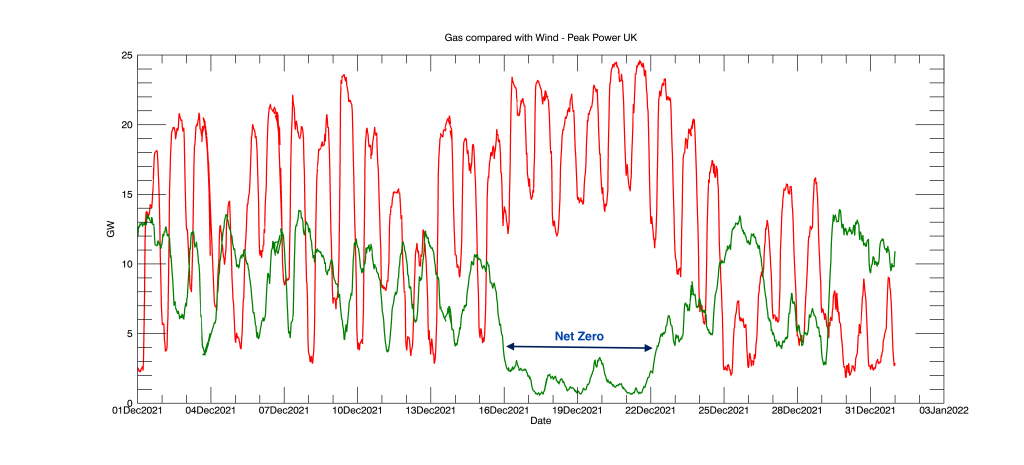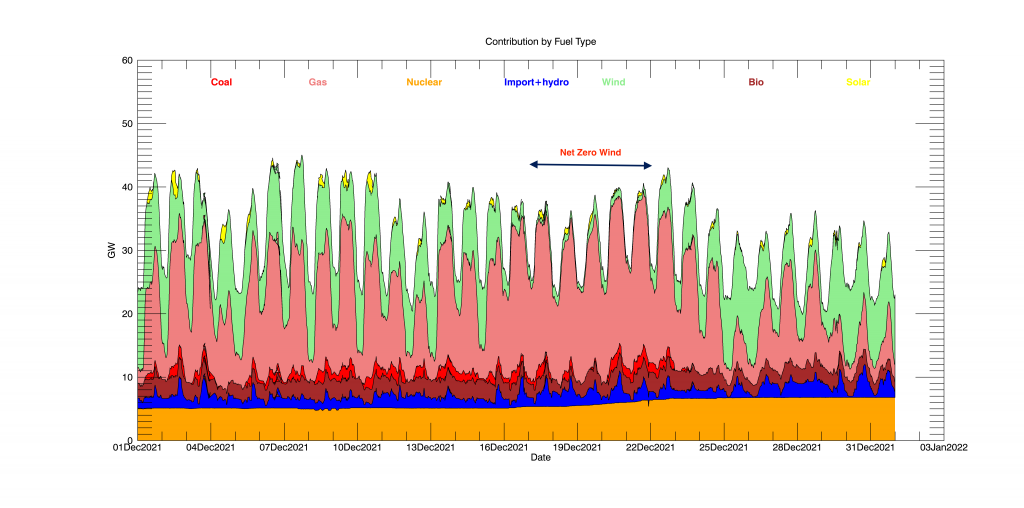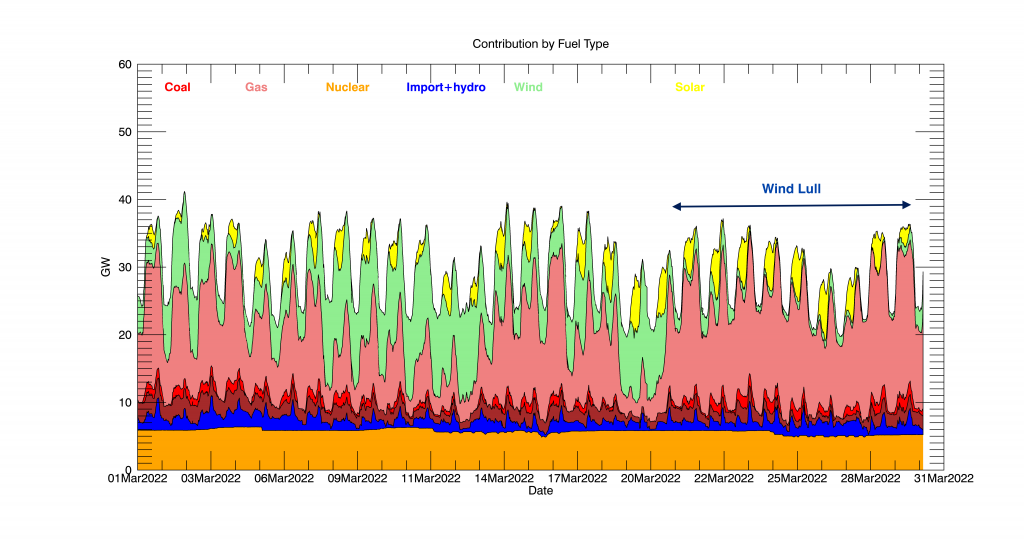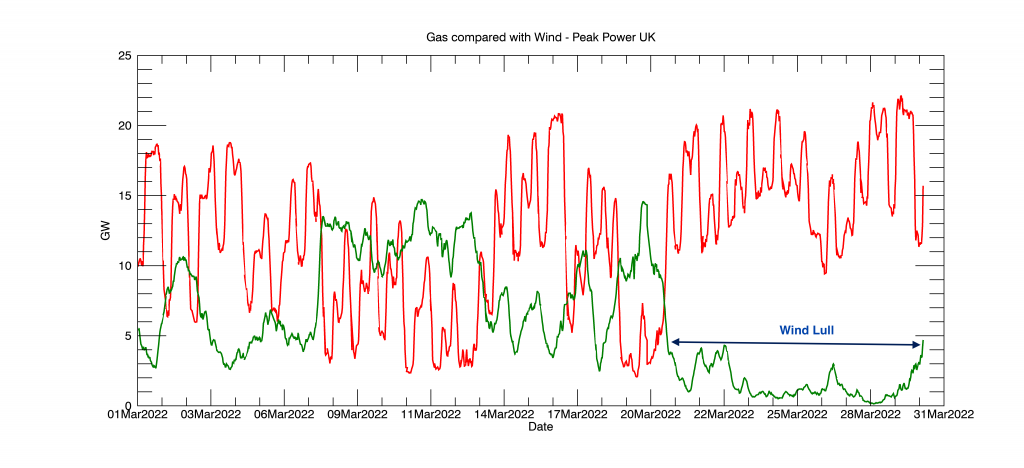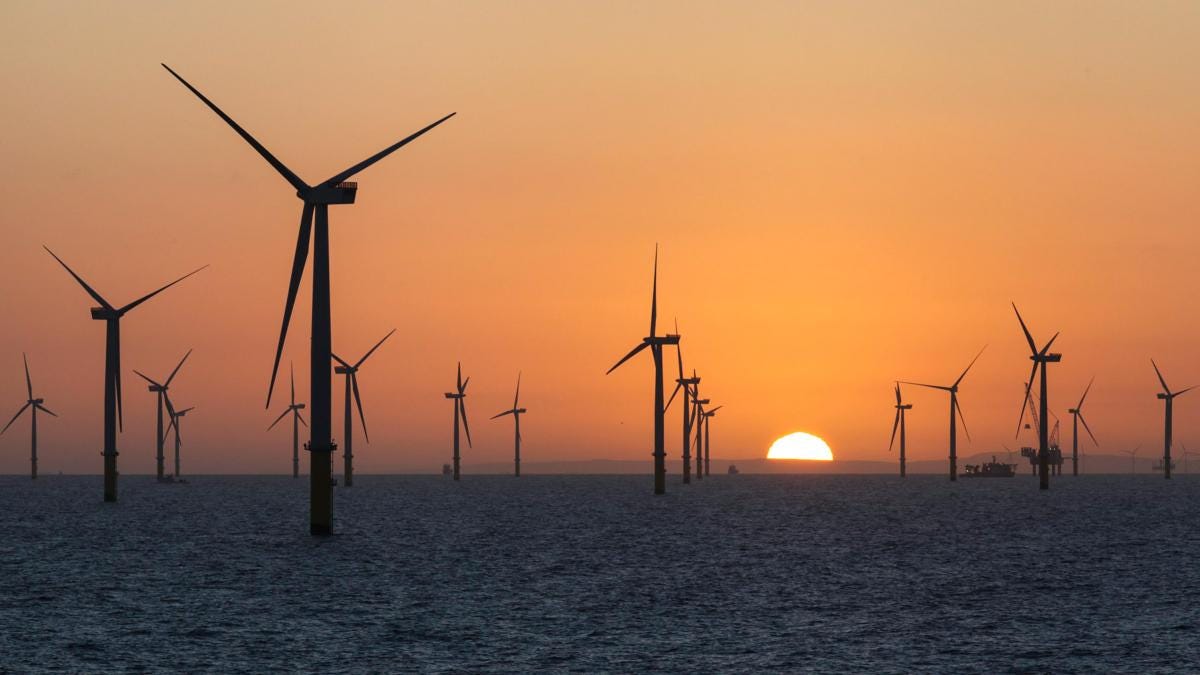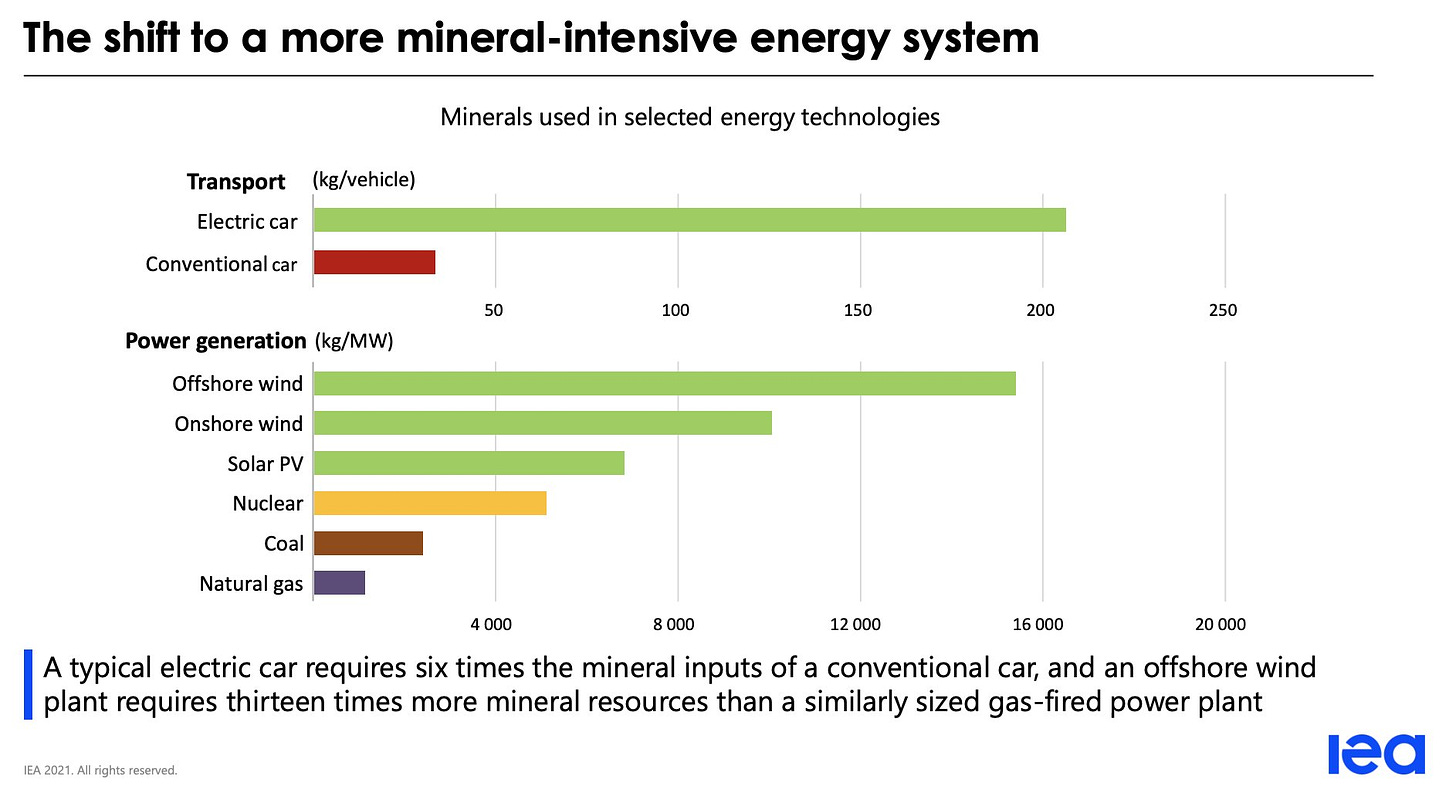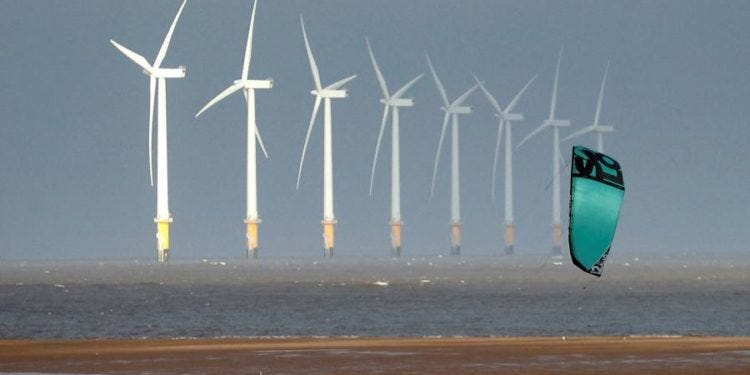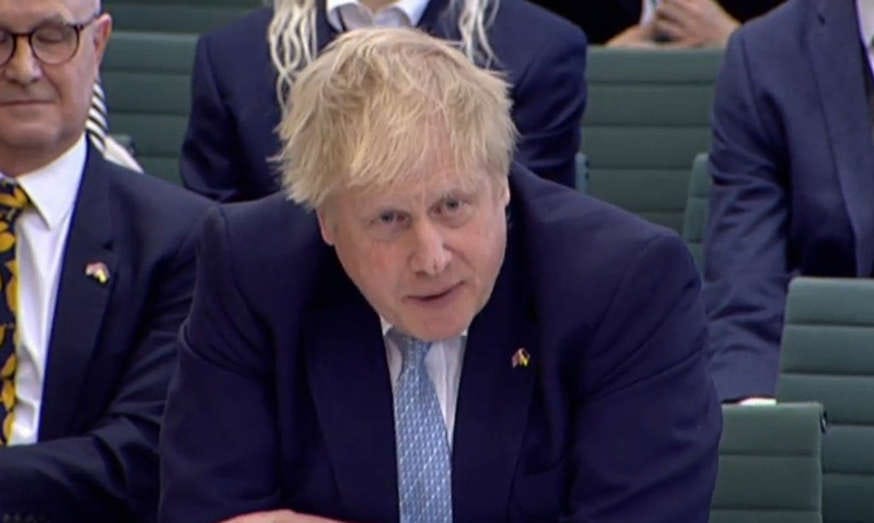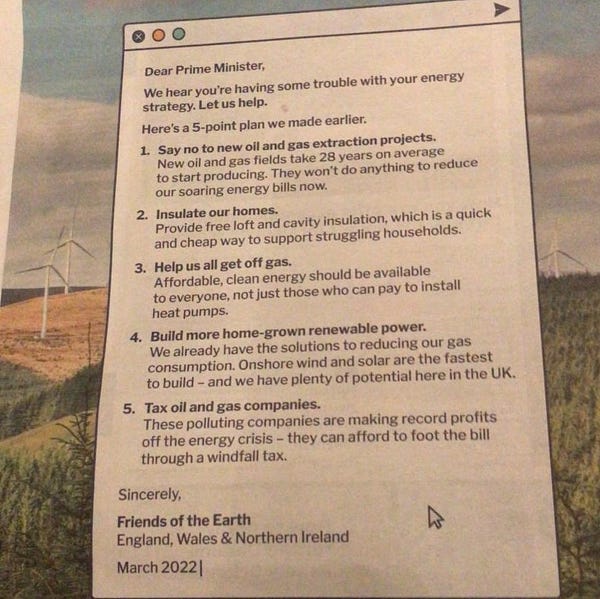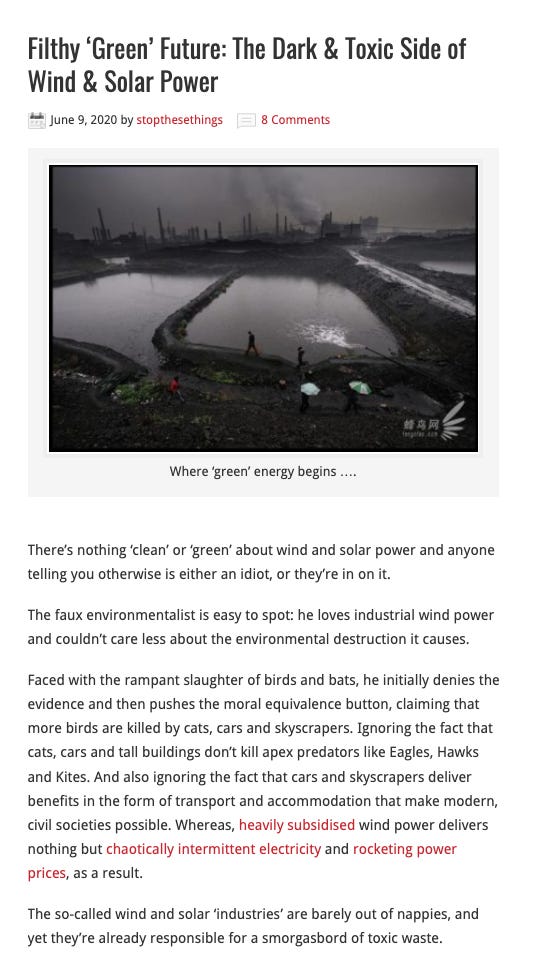More Net Zero Insanity – A collection of articles from March 2022
The following was originally published on my other blog at the end of March 2022.
More Net Zero Insanity
Faux green policies will push more people into fuel poverty whilst desecrating and destroying precious landscapes and ecosystems.
By Azra Dale • 31 March 2022
This is a compilation of some of the information which dispels the myth that industrial wind turbines are allegedly going to help ‘save the planet’ from a ‘climate emergency.’
More Net Zero insanity
By Pete North - March 29, 2022
The Times reports that the power market is facing its biggest overhaul in decades after National Grid said that wholesale electricity should be traded at local prices that vary from town to town. The company responsible for keeping the lights on said that the radical change was needed because Britain’s national electricity market was “not designed for net zero and if left unchanged will impose excessive costs to consumers”.
At present, power plant owners can sell their electricity on the national market, even if there are not enough cables to take that power to where there is consumer demand. That is forcing National Grid’s control room to pay wind and solar farms in remote locations to switch off at times when the network cannot cope and to pay expensive gas plants closer to consumers to switch on and replace them. These “constraint” costs, which are passed on to consumers via their energy bills, have risen sevenfold since 2010 as more renewables have been built, hitting £1.2 billion in 2021.
The National Grid ESO, or Electricity System Operator, warned industry last week that keeping supply and demand in balance nationwide was “becoming more challenging” and was resulting in “dramatic and rising costs for consumers”, even with plans to build lots of expensive new transmission cables. Constraint costs could hit £2.3 billion a year by 2026 without market reform.
Wind energy has already created massive problems for the grid and expanding capacity only exacerbates those balancing problems. This latest proposal is an attempt to disguise the problems wind energy creates.
There is an inherent conflict between the idea of diffuse, local generation and the national grid as currently constituted. It was set up to take a few, large generators from a limited number of locations, and distribute power nationally. Now it is being asked to take small packages of power distributed over a vast range of sites, and still perform the function of ensuring equal distribution of power throughout the nation.
This is something for which the grid was not designed to do, and to make it fit for purpose would require tens of billions of pounds. This money is simply not available and, if it was factored in, it would be seen as part of the cost of renewables provision, pricing it out of the market.
Therefore, National Grid is trying to find solutions on the cheap, without admitting that the system is fundamentally incapable of handling a diffuse, renewables-based generation system. As always, our entire generation system is being built on the basis of dishonesty, pretending the system can do something which it cannot. Local pricing is just dumping because they’ve built energy generation where it cannot be usefully utilised.
The Times has it that a new system would encourage energy-intensive industries to be located near wind farms around the coast or in Scotland to take advantage of cheap wholesale prices for electricity that might otherwise be wasted. That assumes they can afford the inherent transport costs that go with being in a remote location. But it’s quite telling that the economy is being geared around the needs of the Net Zero ideology rather than building a grid to meet the needs of the economy. Moreover, this is in direct conflict with the government’s free ports programme. In reality, this will create an energy price postcode lottery, which energy retailers will spin to incentivise residents in more remote locations to consent to more useless windmills the rest of us will have to pay for.
For the last seven days now wind energy has barely mustered 1GW, supplying a mere 2% of demand, with nuclear and gas doing all the heavy lifting. The cold reality is that wind cannot be relied upon, nor can it be economically integrated into the grid, and Net Zero ambitions simply will not come to pass. Quadrupling wind capacity means quadrupling the amount of dispatchable back up (gas) to cover these long wind outages, or battery storage for something in the range of 24 – 30 days of average usage.
Since battery storage is in its infancy, and prices of materials skyrocketing, as technically unfeasible it is, it is not going to come in any cheaper. Far from it. We’re already set to spend billions on batteries, but this capacity will cover only hours, not days.
Green blob energy wonks are insisting that wind energy is the cheapest form of generation, but only by ignoring the fact that the cost of gas generation is increased by a third due to carbon taxes, ignoring the subsidy bill for renewables, and by lying about the cost of grid “upgrades”. They won’t say how much storage is actually needed or what it is likely to cost, and most of the industry figures are deliberately massaged to mislead politicians. When green wonks talk about “grid upgrades” they mean expensive mitigation of problems they created.
Depressingly, there is no hope of sanity prevailing in the near future. Boris Johnson is pressing ahead with plans to quadruple wind energy, while we learn today from Conservative Environment Network that half of the Conservative Party’s backbenchers support the green agenda. This is very far from the Brexit government elected in 2019. The mask has slipped and the establishment is reverting to business as usual. That can only mean disaster.
Clive Best reports on the reality of wind lulls and why it is complete lunacy to shift to unreliable “renewable” energy.
Wind Lulls
Posted on March 30, 2022 by Clive Best
The installed capacity of UK Wind farms is currently 25GW. The business secretary Kwasi Kwarteng proposes to at least double that number, but there is a basic problem which seemingly everyone overlooks – Wind Lulls. Sometimes high pressure sits over northern Europe for many days on end bringing still air with no wind. All UK, German and French wind turbines are becalmed producing little if any power. Life and essential services has to continue so old coal stations are fired up and CC Gas stations run at maximum output to meet peak demand.
Here are two recent examples:
The 7 day lull from 16-22 December 2021
Comparison of Gas and Wind output during the 7 day Wind Lull last December.
We also see below how coal is still needed to balance power on the grid.
The recent 10 day wind lull lasting 10 days. At least this time there was a bit of sunshine yet notice again how the remaining 2 coal power stations were also needed . The whole of March saw only two brief spells of good wind output.
10 day wind lull March 20 – March 30
Most of March saw light winds. Output reached a maximum of 15GW briefly or a maximum load capacity of 60% . Note that I am also correcting the metered wind output to include embedded small wind farms as well.
Gas output compared to wind output – almost perfect anti-correlation.
Don’t worry though we are told. We just need “energy storage”, but no-one ever calculates just how much energy we would need store in order to see us through a wind drought like we have just experienced or the one last December.
In December there was additionally no solar power generated. In fact solar energy is perversely anti-correlated to demand. Annual peak demand is around 6pm on winter evenings when solar energy output is zero. So let’s estimate how much energy would need to be stored to cover the December lull.
We need 7 days of continuous power delivery at an average load of 30GW. So we need to store:
7 x 24 x 30 = 5040 GWh or 1.8 x 10**16 joules
This is a huge amount of energy which is approximately equivalent to
1200 Hiroshima size bombs
373 million fully charged Tesla Powerwalls
67.2 million long range Tesla 3 car battery charges
So it is unlikely that any future fleet of electric cars can back up the grid, assuming their owners would agree to walk rather than drive during a wind lull.
The largest energy store in the UK is the Dinorwig pumped storage Power Station in Snowdonia. It took 10 years to construct but actually paid for itself within 2 years by balancing peak time loads. It can store up to 9.1 GWh of energy which is a useful power source over short periods. However it is still 500 times too small to balance a wind dominated energy grid for a week. Nor do we have enough mountains to dramatically increase such pumped storage systems.
The largest Tesla grid size battery storage is in Hornsdale Southern Australia. It can store 193 MWh which is useful to cover short outages but still way too small for a wind lull.
As David MacKay used to say “We need an Energy Policy which adds up”.
See also:
Britain faces an energy emergency as lack of wind exposes tottering electricity system, rescued by coal
Friday 6th November 2020 | Global Warming Policy Forum (GWPF)
London, 6 November: The Global Warming Policy Forum (GWPF) is today calling on MPs to start an urgent inquiry into the economic and national security implications of the growing fragility of the UK electricity system.
For two days running, (4th and 5th November), National Grid, UK’s Electricity System Operator has issued System Warnings in the form of an Electricity Margin Notice, alerting the markets to a reduced system margin. In large part this is due to low levels of wind power as a result of a very large high pressure system that covers the whole of the UK, bringing the first frosts of the winter.
At peak load on the 4th of November the UK’s entire transmission connected wind fleet of 18,000 MW in capacity was providing a mere 17% of its possible output (3,000 MW).
The last of the UK’s remaining coal plants stepped in and provided over 2,264 MW of generation, alongside other conventional forms of generation. For a government that claims to be “Powering Past Coal” this is deeply embarrassing.
The UK’s electricity sector is now so fragile that a normal weather event causes it to wilt like a hothouse plant left out in the frost, and the prospects for the future are deeply troubling.
Much of the conventional capacity that has been stabilising the system in the last two days, particularly coal, is scheduled for rapid closure in the drive towards Net Zero. This hasty policy has long looked overambitious, it now appears dangerous as well as ruinously expensive.
The government has become a hostage to renewables industry lobbyists, inside and outside Westminster, and will not spontaneously initiate an inquiry into the threat to energy and national security or admit failure. The GWPF is calling for MPs to initiate their own investigation of the perilous state of the United Kingdom’s electricity system.
Amongst the questions that MPs should be asking are:
1) Why was National Grid caught out by the weather, and how much has their mistake cost consumers?
2) How can we quickly pause and unwind the increasingly dangerous reliance on renewables and wind power?
3) Does the UK have to extend the lives of coal and older gas generators in order to limit the risk of security of supply and control consumer costs?
4) Should the UK create a market that delivers a long-term cost-minimisation strategy for electricity?
Dr John Constable, the GWPF energy editor, said:
The engineering of our electricity industry is a national embarrassment, with National Grid sent into a panic by the first mild frosts of winter, and consumer costs at horrific levels. The renewables policy of the last twenty years is to blame and government must now change course.”
Note for editors:
For technical and background information see “Colder weather and low winds expose UK electricity system weakness”
Having been involved in the ongoing battle against the proliferation of not clean nor green, unreliable industrial wind installations (as opposed to the soft marketing term wind “farms”) in Wales since 2017, I am in complete agreement that renewable energy is a massive lie.
From our experiences with Hendy Wind Farm in particular, I can also attest to the fact that the developers we have had to deal with are incredibly corrupt. Down the Rabbit Hole published in January 2019 provides an overview of how the Hendy Wind Farm saga kicked off after planning permission was granted under questionable circumstances. It’s not over yet with a related crew now planning several other industrial wind installations in this ancient sacred landscape, including the domed hills of the Radnor Forest where legend has it the last Dragon of Wales sleeps.Renewable energy: the new big lie
By Pete North - March 30, 2022
In 2020, 75 percent of all imports of panels into the EU came from China, according to Eurostat, the EU’s statistics agency. If you were to decide in February 2022 that you want to suddenly buy from crystalline solar companies that have nothing to do with Xinjiang you would have almost no choice. That makes Net Zero advocates complicit in massive abuses of human rights. If they weren’t hypocrites, they would be protesting any new solar farms.
The US has already imposed an effective ban on Chinese solar panels, and the EU, last time I looked, was also leaning in that direction. The EU rarely revokes trade preferences for human rights abusers, but even the EU can’t sit on its hands on this matter. For now it has settled upon supply chain transparency measures under the corporate governance directive, but corporates know how to get around such measures with plausible deniability.
But if you think that reducing food miles is a necessary step to achieving zero emissions, where is the sense in paving over our farmland with black rectangles filled with silicon? It would appear the main attraction for solar developers is that planning permission for solar changes the land use classification, which allows them to build on the land later down the line. They’re greenwashing a form of land banking.
Green activists on Twitter have gone into overdrive following seven days of next to zero output from renewable sources. They’re still claiming that renewables are cheap and getting cheaper. They seem not to have noticed that the price of raw materials and shipping has gone into orbit. They’re working from completely obsolete narratives, having assumed trends over the last decade would continue on the same trajectory.
They are wrong. Not only are they wrong, prices were already turning upward before anyone had ever heard of Covid 19, and global shipping was in crisis. Following two years of lockdowns and now Ukraine, there is zero likelihood of returning to pre-Covid norms. An era in geopolitics has come to an end and globalisation is quietly imploding.
To talk of renewables being cheap was a lie before and it’s an even bigger lie now. Decades of policy neglect now means there is no cheap option. If we wanted to escape sky high food and energy prices then we needed action at least a decade ago. Had we invested in nuclear instead of windmills we would not now be needing to buy gas at peak prices when the wind isn’t blowing. The green agenda has increased our dependency on gas and energy imports, it has dangerously exposed Britain to price volatility and is set to make life considerably harder even for the comfortably off.
It was obvious to energy watchers that the obsession with wind turbines would lead to this point. Christopher Booker in The Sunday Telegraph was writing about it as far back as 2005, saying that wind would cause massive grid instability and bring us to the brink of rolling blackouts. We got lucky this year with a mild winter, but if we’d had sustained low temperatures over December and January, we might very well have seen all energy intensive industries ordered to power down. The national grid is already exploring this option for the near future.
But then green energy wonks always knew this was an inherent risk, but assured us then as they do now, that intermittency could be mitigated by smart grids, metering and battery storage. None of this has yet materialised at scale, and is unlikely to. Grid scale battery storage is nowhere close to plugging the capacity gaps when the wind does not blow and the cost of manufacturing batteries is only going to skyrocket. China has spent the last twenty years cornering the global market in rare earth minerals and metals while there is major global competition for them for all manner of uses. A pivot away from Russia means a pivot towards Communist China and slave labour.
Net Zero is not a transition to clean energy. It is (notionally) a shift away from fossil fuels, but more accurately, it is a transition to a mineral intensive energy system. A typical electric car uses six times the mineral inputs of a conventional car, and an offshore wind farm uses thirteen times more mineral resources than a similarly sized gas powered plant – according to the International Energy Agency. I have yet to see a single renewables evangelist grapple with this reality. We get plenty of obfuscation and misdirection, but no acknowledgment that the costs of renewables could never stabilise.
Alarmingly, these green blob activists are in influential positions, dominating the flow of information in the media and politics, ensuring our politicians are misinformed and misled about costs. The metric of energy costs (Levelised Cost) is deeply misleading in that it does not account for the massive system externalities created by wind (ie. the need for grid balancing and transmission costs) while ignoring that wind is heavily subsidised and gas is subject to massive carbon taxes. The renewables lobby makes Boris Johnson look like a pillar of truth and integrity.
The national grid was never designed to cope with a wide array of intermittent sources, requiring hundreds of billions of investment to solve a problem the green lobby created. Society is being redesigned to meet the needs of the Net Zero ideology rather than the needs of the people. We’re going from relatively affordable energy when we want it, to unaffordable rationed energy.
The green lobby is turning the clock back on human progress. We could not afford this at the best of times, but to double down on it now, as the Tories are intent upon, is not only economic suicide, it is profoundly sinister. It will exacerbate hunger and extreme poverty, cause a jobs emergency and plunge the country into darkness – while refusing the pubic a meaningful say in it. We could be heading for a constitutional crisis as well as an economic one.
Flip. Flop.
UK unlikely to authorise big expansion of onshore wind farms
March 30, 2022
Boris Johnson on Wednesday signalled a big role for offshore wind farms in the government’s new energy supply strategy, but played down the prospect of a significant expansion of land-based turbines.
The prime minister’s allies said he was still “open to looking at onshore wind”, but many Conservative MPs are hostile to the idea because of local opposition in Tory heartlands.
Johnson heralded the energy supply strategy — which ministers hope to publish next week — by stressing the contribution that would be played by sea-based wind turbines and nuclear power.
The strategy, designed to refocus UK energy policy on domestic sources of power after Russia’s invasion of Ukraine, has been delayed for several weeks as the Treasury haggles over the cost of new nuclear power stations.
Business secretary Kwasi Kwarteng wants to accelerate drilling for North Sea oil and gas, build more nuclear reactors and increase use of renewable energy, including solar, offshore and onshore wind.
Speaking at the House of Commons liaison committee on Wednesday, Johnson said: “Renewables are fantastic and offshore wind — and I stress offshore wind — I think has massive potential. But so does nuclear.”
He said the UK had failed to build enough long-term energy supply for “a generation”, describing that lack of planning as “one of those colossal mistakes”.
An early draft of the energy strategy, approved by Kwarteng, includes 50 gigawatts of solar capacity, 50GW of offshore wind and 30GW of onshore wind by 2030.
Government officials said Johnson had not yet signed off the strategy, meaning the onshore wind target could be scaled back.
Johnson emphasised that fossil fuels would stay part of Britain’s energy mix for years as part of a gradual transition to the UK target of net zero emissions by 2050.
The energy security strategy is partly a response to the cost of living crisis, which has been driven by big rises in gas and oil prices, worsened by the war in Ukraine.
Johnson was criticised on Wednesday by Labour leader Sir Keir Starmer over what he claimed was the government’s “utterly cynical” approach to helping people with their living costs.
Energy is the world’s indispensable business and Energy Source is its newsletter. Every Tuesday and Thursday, direct to your inbox, Energy Source brings you essential news, forward-thinking analysis and insider intelligence. Sign up here.
Starmer highlighted findings by the Office for Budget Responsibility that tax cuts in last week’s Spring Statement would only undo one-sixth of the tax rises introduced by Rishi Sunak since he became chancellor in February 2020.
Johnson told MPs there would be direct support for those facing “particular hardships” because of surging inflation, adding that the government’s focus was helping people into work.
Asked about rising child poverty, the prime minister said: “I am not going to pretend it is easy, but we are going to go at it as hard as we can.”
Gemma Tetlow, chief economist at the Institute for Government, a think-tank, said less well off households, who spent a higher proportion of their incomes on gas bills and essentials compared to affluent families, would be “most severely hit” by the cost of living crunch.
Source: Financial Times via FBN Global News.
Not surprisingly, the comments made by Boris yesterday created a chorus of whinging from the green blob.
‘Absolutely bizarre’: Dismay from climate campaigners as PM comes out against onshore wind farms
Andrew Woodcock and Saphora Smith • 31 March 2022
Boris Johnson has come down against onshore wind farms in the cabinet row which has delayed the publication of his energy security strategy.
© UK Parliament
The PM gives evidence to the Commons Liaison Committee on Wednesday
- UK Parliament
His comments dismayed environmentalists who believe that the development of onshore wind power is a vital part of the UK’s move towards net zero carbon emissions by the 2050 target.
Environment think tank Green Alliance said it was “absolutely bizarre” to seemingly exclude one of the UK’s cheapest energy sources from the nation’s future power mix.
The prime minister had been reported to be leaning towards business secretary Kwasi Kwarteng’s drive for the relaxation of planning rules to allow more onshore turbines, in the face of opposition from ministers including Jacob Rees-Mogg.
But giving evidence to a parliamentary committee today, he singled out offshore wind farms as a priority for the UK’s future energy supplies. And he underlined the fact that he was drawing a distinction with developments on land by repeating the word “offshore”.
It is now almost a month since Mr Johnson promised an energy security strategy “in the coming deadlock over onshore wind in time to allow the document to be released next week, ahead of the purdah in the run-up to May’s local elections.
Setting out his plans for the long-delayed strategy, Mr Johnson told the Commons Liaison Committee: “In the UK we have failed for a generation to put in enough long-term supply and it’s been one of those colossal mistakes.
“Renewables are fantastic and offshore wind – and I stress offshore wind – I think has massive potential. But so does nuclear.”
Green Alliance senior political adviser Joe Tetlow said the government should show “leadership” over onshore wind rather than ruling it out for fear of a “not in my back yard” response from communities close to the sites of proposed facilities.
“It’s 2022, not 2012,” Mr Tetlow told The Independent. “People support onshore wind.
“They recognise we need it for energy independence, for national security, and to bring down bills. Of course we need community support, but we also need political leadership.”
And Danny Gross, energy campaigner at Friends of the Earth, said Mr Johnson “cannot afford” to ignore onshore wind if he is serious about dealing with the energy crisis.
“On average it takes six years to develop an onshore wind farm, compared with 28 years for new oil and gas fields,” Mr Gross said. “Johnson’s energy review must focus on unlocking the nation’s huge renewable potential, and this must include ending the unfair planning rules that hamper onshore wind.”
Mr Johnson said he wanted to accelerate a new generation of nuclear power in the UK, telling MPs that new-style small nuclear reactors (SMRs) being developed by Rolls Royce could be on-stream by the end of the 2020s.
But he said that fossil fuels would remain part of the country’s energy mix, both as part of the transition to renewable sources and as an element in the production of hydrogen energy.
He insisted that the ambition to put the UK on the path to net zero “has not been adulterated or lost at all”. But despite the UK’s decarbonisation promises at the Cop26 summit last year, he said it would be “very useful” to continue oil and gas exploration in the North Sea.
Mr Johnson told MPs he could not claim that new nuclear reactors would be producing electricity “in the next couple of years”.
But he added: “We’ve got to be looking at big-ticket nuclear solutions – Sizewell and other projects – but we’re also going to be looking at small modular reactors.
“The Qataris are just one of the countries that wants to work with us on SMRs. There’s a huge list of potential partners for Rolls Royce... If we don’t start now, we won’t be fixing the problem.”
Mr Johnson’s remarks came after 14 green groups called on the government earlier this week to “unblock” onshore wind in England.
Green groups have repeatedly pointed out that wind is popular, clean and cheap. A YouGov poll last year found that 70 per cent of respondents supported the installation of more onshore wind turbines in the UK.
A more recent report by the Department of Business, Energy and Industrial Strategy found that 80 percent of people supported onshore wind.
In 2020, the government estimated that onshore wind would cost around £46 per megawatt-hour by 2025, compared to £85 for gas. The estimates suggest it will be the second cheapest energy source after large solar in 2025, according to analysis by Carbon Brief.
These so-called “green groups” are either wilfully ignorant or they don’t have a clue about the enormous damage to birds, bats, insects, water courses, ecosystems and much more caused by not clean nor green wind and solar “renewable energy”, along with the electric vehicles they want us all to be driving in a few short years. In reality, their schemes for allegedly “saving the planet” will in fact destroy it.
Click on the screenshot to continue reading.

